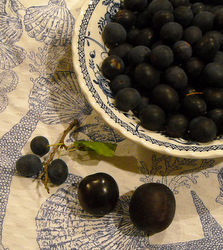Wild damson vodka recipe. How to identify wild damsons
Posted by Fiona Nevile in Liqueurs | 40 comments
Left to right: wild damsons, bullace and eating plum
Wild damsons (the ones in the bowl) are the size of a small olive and have the same elongated shape. The dark bluish skins have the same greyish tinge of a sloe or dark plum. The flesh is a yellow orange and the stone small. If you want an instant tongue defuzz bite into one – it is very sharp but not quite as bitter as a sloe. The leaves of a tree are similar to a plum leaf but smaller.
The photo shows wild damsons, a bullace and a dark plum. A cherry plum is smaller than a bullace but larger than a wild damson. A sloe is similar in colour to a wild damson but it is round.
Wild damsons are so hard to find that if you do discover them on a foraging expedition, never share the whereabouts with anyone. I did this once and returned to find the tree bare. To add salt to the wound the fruit was still not ripe. You can leave unripe fruit on a windowsill to ripen but it will not swell or be at its best. Wild damson trees tend to be spindly. They are hedgerow plants. Deep in their ancestry they have sloe and cherry plum relations.
It’s OK leave a sealed envelope for your family to be opened after your death but never divulge your secret. It is the key fruit in one of the best homemade liqueurs know to man or beast – wild damson vodka. Clean tasting, heart hugging grog.
Even Gilbert doesn’t know where my secret tree is located.
There is one couple that does. They spotted it when they came to the Cottage Smallholder party last month.
“There’s a tree out there with small purple olive shaped berries…”
My heart sank.
“Are they wild damsons?”
I couldn’t lie – the couple were new friends after all. The fruit weren’t ripe but generally this doesn’t rein in the keenest foragers.
“You’ve found my secret tree. Let’s share.”
Better half a harvest than none at all.
Over the years I’ve grown with this tree. First just enough fruit for a tiny bottle, then a half bottle moving up through the sizes to a litre bottle of wild damson gin last year. Each one treasured and hidden away in the barn. The gin was very good but I think that the vodka version wins hands down. Sharper, cleaner and fruitier tasting.
I hadn’t had the heart to look at the ‘secret tree’ until a couple of days ago. I glanced up at the tree. It was heavy with fruit. I gathered all that I could reach and my pockets were bulging. Enough for two litres of wild damson vodka and more to make a fine jelly for lamb, turkey or game – if I climb up a wall and use my foraging walking stick to gently pull down the laden branches.
Thank you Chris (aka Paperman on our forum) and Anne. At Easter you’ll receive a slim bottle in the post and before that some interesting and intoxicating wild damson jelly to enhance your Christmas jollifications. And there will be regular bribes to guarantee that your lips are sealed.
| Wild damson vodka recipe |
- • 1lb/454gm of washed wild damsons
- • 6 ozs/168gm of white granulated sugar
- • 75cl bottle of medium quality vodka
- • Sterilised 1 litre (at least) Le Parfait jar or wide necked bottle with stopper/cork
- Wash the wild damsons well and discard any bad or bruised fruit. There is no need to prick the fruit with a fork (but you can if you want to be brutal) just place damsons in either a large Kilner/Le Parfait jar or a wide necked 1 litre bottle.
- Using a funnel, add the sugar and top up with vodka to the rim. If you leave a bigger gap the liqueur might spoil with the excess of air.
- Shake every day until the sugar is dissolved and then store in a cool, dark place until you can resist it no longer (leave for at least three months, we usually let it mature for a year). If you are planning to drink this after 3 months, have a nip after a month, and top up with sugar to taste.
- Some people strain the grog (through muslin/jelly bag) after 3 months and bottle it, leaving it mature for six months. We strain and bottle after a year. Don’t leave the straining process any longer than a year; leaving the fruit in too long can spoil the liqueur, as we found to our cost one year.
- Use the leftover fruit to make a great jelly for game or to accompany a dull roast. Or try adding sherry to the fruit. Leave for at least a couple of months. This is cheap jet fuel so beware.
Leave a reply






Thanks for the tip!!!
I’m gonna do it tomorrow
I think.
My neighbour gave me some foragged damsons and after reading this I want to make the vodka.
I froze them however – should I just let them defrost then make or chuck them in without defrosting?
I can always do jam if this won’t work.
Hi Russell
Fresh, frozen and unfrozen all work the same. If you do unfreeze them remember to pour in the juice as well.
I am very lucky to live in an area of Shropshire known as “damson valley” there are hundreds of damsons trees, they line the streets and roads and there are lots in the small villages around – mostly pretty easy to get to. There are also many sloes and other types of plum – we are blessed 🙂
Hi Tasha – Lucky, lucky you!
I haven’t seen wild damsons before but there are ‘regular’ damsons growing near our house. Also last week I was out walking and discovered a whole row of both sloes and wild plums/small bullace only a short distance from a path which I regularly walk down.
This afternoon I tried one of the plums since they felt soft and ripe. It was very very sour so I think I’ll definitely leave them on the tree a while longer.
I know exactly what you mean.
I find it so disheartening to find just how many foragers are “greedy grabbers” – rather than “fair sharers”. Its also the case that the “greedy grabbers” DO often get in there and “grab” before the item concerned is ripe (ie so concerned are they to grab other peoples share – as well as their own).
It IS a bugbear of mine – and I havent been able to devize an answer to this yet…
The only consolation sometimes is karma…
ceridwen
Hmm… must keep my eyes peeled. I may be missing out on a little treasure. (I think him indoors gets a bit worried when I bring back something foraged!)
Yeah my wife was a bit worried in case I tasted this wild bluish mauve fruit but not shiny, kind of like a peach is. Have studied this site I think they are sloes as they have thorns on the bushes. The bush is called blackthorn I believe but it produces sloes.
Ooh, I saw one of those on Sunday! I assumed it was a sloe tree but it didn’t have so many berries and the branches were quite spindly, as per your description.
How exciting! I think I might have found a wild damson tree near my house. It might be a bullace tree though. Armed with my new knowledge I’m going to go down and check tonight.
I think I know of a wild damson near me in an old hedgerow- I’ll go and have a look and have a go. I also see sloes in this same hedgerow, so will have some of those when they are ready.
We have a greengage tree in our garden. The OH is not interested in the fruit as she does not like them. Several neihgbours do so they get shared around.
Any greengage grog recipes out there?
Fiona – the fruit in the middle is not bullace. We have a number of bullace trees in our garden and the fruit at present is green, eventually it will turn yellow with a pink flush. Like a small, ripe greengage. We also have damson trees in the garden which grow wild with an abundance of fruit this year. Will pick some for damson vodka shortly.